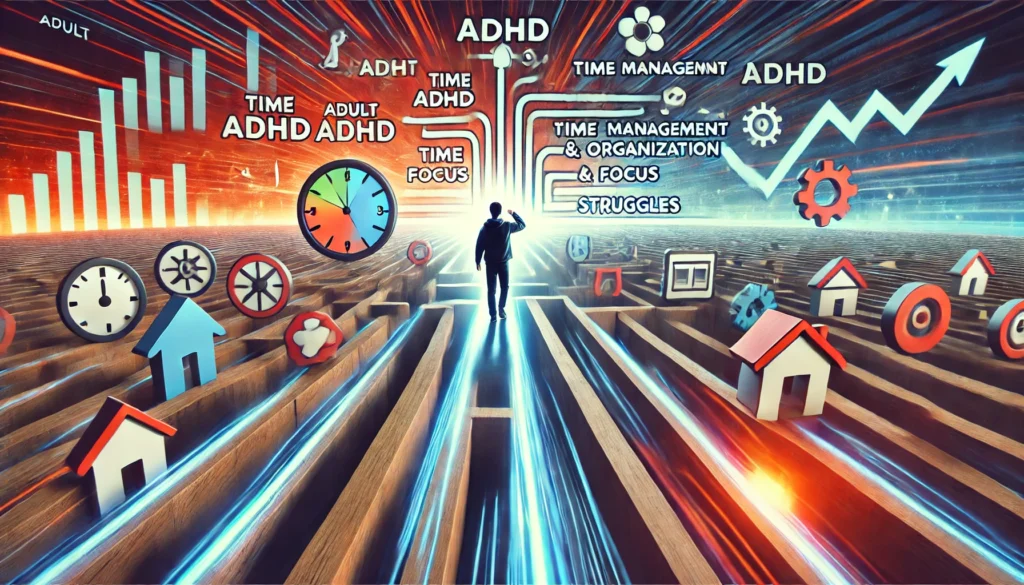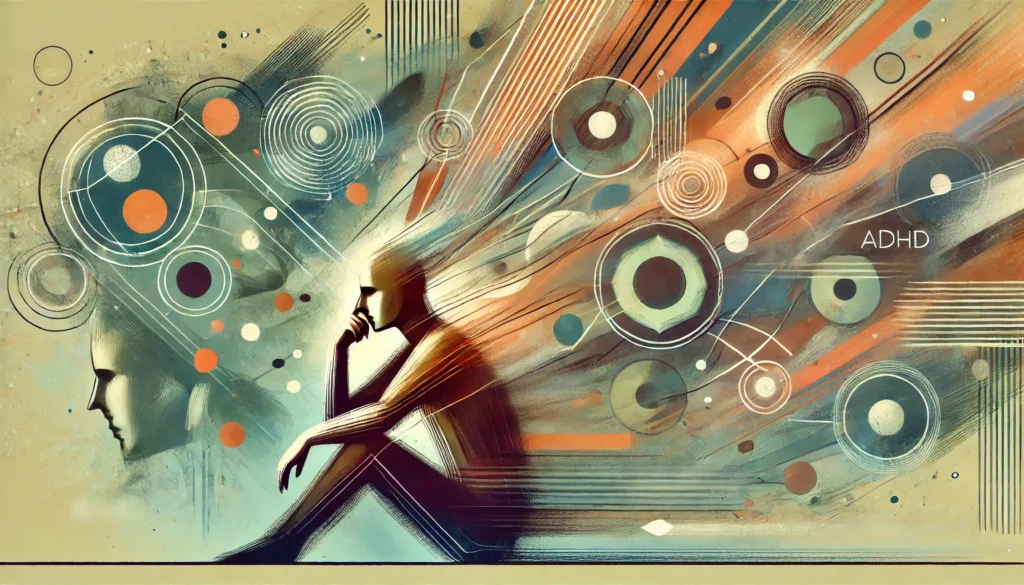Before diving into specific techniques, it’s essential to grasp the neurological underpinnings of ADHD. Characterized by differences in brain activity that affect attention regulation, impulse control, and executive function, ADHD manifests in unique ways in adulthood. It’s not merely a childhood condition that adults outgrow; rather, it persists, often requiring new strategies to manage it effectively.
You may also like: Enhancing Concentration: Strategies for ADHD
The Science Behind ADHD
Adults living with ADHD may experience difficulties in sustaining attention, organizing tasks, and managing time. These challenges are rooted in the brain’s prefrontal cortex, the region responsible for executive functions. Disruptions in neurotransmitters like dopamine and norepinephrine also contribute to the symptoms of ADHD, influencing motivation and focus.
Historical perspectives on ADHD have evolved, from initial mischaracterizations as a lack of willpower to a nuanced understanding of its neurobiological basis. This shift has paved the way for more effective interventions and coping mechanisms.
Neurological Differences
The ADHD brain functions differently, with notable variations in brain structure and chemical activity. Research shows that adults with ADHD have smaller prefrontal cortex volumes and altered neural pathways. These differences can lead to challenges in decision-making, impulse control, and working memory, making everyday tasks more complex.
Impact on Daily Life
The impact of ADHD on daily life extends beyond just focus. Adults may struggle with emotional regulation, leading to heightened sensitivity to stress and frustration. These emotional challenges can affect personal relationships and professional dynamics, highlighting the importance of comprehensive management strategies.
Evolution of Understanding
Over the decades, the understanding of ADHD has significantly progressed. Previously dismissed as a childhood issue or attributed to poor upbringing, it is now recognized as a legitimate neurodevelopmental disorder. This evolution has opened doors to tailored therapies and support systems that address the unique needs of adults with ADHD.

Practical Productivity Hacks
Now that we have a foundational understanding of ADHD, let’s explore some practical productivity hacks that can make a significant difference in daily life.
1. Prioritize Tasks with the Eisenhower Box
The Eisenhower Box is a simple decision-making tool that can help prioritize tasks based on urgency and importance. By dividing tasks into four quadrants—urgent and important, important but not urgent, urgent but not important, and neither urgent nor important—adults with ADHD can focus their efforts on what truly matters, reducing overwhelm and enhancing productivity.
Breaking Down Prioritization
Breaking down tasks into manageable parts is crucial for those with ADHD. The Eisenhower Box encourages this by forcing a clear distinction between what needs immediate attention and what can be postponed. This structured approach reduces the mental clutter that often accompanies ADHD, providing clarity and direction.
Visual Reminders
Visual aids, like color-coded charts or digital reminders, can complement the Eisenhower Box technique. These tools help keep important tasks front and center, preventing them from being overshadowed by less critical activities. Visual reminders are particularly beneficial for those who find written lists overwhelming.
Daily Review Sessions
Incorporating a daily review session to reassess priorities can enhance the effectiveness of the Eisenhower Box. By regularly updating the task list, individuals can adjust to new developments and stay on track. This routine not only boosts productivity but also instills a sense of control and accomplishment.
2. Leverage Technology for Time Management
Digital tools can be invaluable for those living with adult ADHD. Apps like Trello, Todoist, and Pomodoro timers offer structure and help manage time effectively. These applications can break tasks into smaller, manageable parts and remind users to take regular breaks, preventing burnout and maintaining focus.
Choosing the Right Tools
Selecting the right time management tools can be a game-changer. It’s important to choose applications that resonate with personal preferences and workflow. Whether it’s a visual board like Trello or a checklist app like Todoist, the key is finding a tool that simplifies task management without adding complexity.
Integrating Technology into Daily Routines
Integrating these technological tools seamlessly into daily routines can enhance their effectiveness. Setting reminders and alerts on smartphones or smartwatches ensures that important tasks are not forgotten. Regularly syncing calendars and task lists helps maintain organization and reduces the risk of double-booking or missed deadlines.
Overcoming Digital Overload
While technology offers great benefits, it can also lead to digital overload. Setting boundaries on screen time and using features like “Do Not Disturb” during focused work periods can prevent distractions. It’s important to balance the use of digital tools with offline strategies to maintain mental clarity.
3. Create a Distraction-Free Workspace
A cluttered environment can exacerbate ADHD symptoms, making it difficult to concentrate. Designating a specific area for work, minimizing distractions, and using noise-canceling headphones can create a conducive environment for productivity.
Designing an ADHD-Friendly Workspace
Designing a workspace that caters to the needs of ADHD individuals involves more than just decluttering. It’s about creating an environment that minimizes sensory overload. Using soothing colors, adequate lighting, and ergonomic furniture can significantly enhance comfort and focus.
The Role of Sensory Tools
Incorporating sensory tools, such as fidget spinners or textured items, can help channel excess energy and maintain focus. These tools provide subtle stimulation, allowing individuals to concentrate better on their tasks. Identifying personal preferences in sensory aids can be a powerful addition to the workspace setup.
The Power of Routine in the Workspace
Establishing a routine within the workspace can further bolster productivity. This includes having designated times for specific tasks, scheduled breaks, and end-of-day rituals. A structured approach reduces decision fatigue and fosters a sense of predictability, which is particularly beneficial for those with ADHD.
4. Implement Mindfulness and Meditation
Mindfulness and meditation practices have been shown to improve attention and executive function in individuals with ADHD. Techniques such as deep breathing, guided meditation, and mindfulness exercises can help calm the mind, reduce stress, and enhance focus.
Understanding Mindfulness and Its Benefits
Mindfulness involves being fully present in the moment, acknowledging thoughts and feelings without judgment. For adults with ADHD, this practice can mitigate the constant stream of thoughts and distractions. Regular mindfulness exercises can lead to improved emotional regulation and reduced anxiety levels.
Guided Meditation Techniques
Guided meditation provides a structured approach to mindfulness, making it accessible for beginners. Audio guides and apps can lead individuals through visualization techniques and breathing exercises, promoting relaxation and focus. Consistent practice, even for a few minutes daily, can yield significant benefits over time.
Incorporating Mindfulness into Daily Life
Incorporating mindfulness into everyday activities, such as mindful eating or walking, can make it a natural part of life. These practices encourage individuals to engage fully with their surroundings, enhancing awareness and concentration. Over time, mindfulness becomes a tool for navigating the challenges of ADHD with greater ease.

Building Sustainable Habits
5. Establish Routine and Consistency
Creating a consistent daily routine can provide structure and predictability, which is beneficial for those with ADHD. By setting specific times for waking up, working, and taking breaks, individuals can develop habits that promote stability and productivity.
Crafting a Personalized Routine
Crafting a routine that aligns with personal energy levels and preferences is crucial. Morning people might schedule demanding tasks early, while night owls could reserve evenings for focused work. Tailoring routines to individual needs enhances adherence and effectiveness.
Adapting to Changes
Flexibility within a routine is important to accommodate life’s unpredictabilities. Having contingency plans for unexpected events ensures that productivity doesn’t derail. This adaptability fosters resilience, empowering individuals to maintain momentum even amidst changes.
Monitoring Progress and Making Adjustments
Regularly assessing the effectiveness of a routine allows for timely adjustments. Tracking progress helps identify what’s working and what needs tweaking. This ongoing evaluation ensures that routines evolve with personal growth and changing circumstances.
6. Exercise Regularly
Physical activity is not only beneficial for overall health but also for managing ADHD symptoms. Exercise increases dopamine and norepinephrine levels, which are crucial for attention and focus. Incorporating regular physical activity into your routine can boost energy levels and improve concentration.
Exploring Different Types of Exercise
Different types of exercise, from cardio to strength training, offer varied benefits for ADHD management. Aerobic activities like running or cycling boost endorphins, while yoga and tai chi enhance mind-body connection. Experimenting with various forms can help identify the most enjoyable and effective exercise.
The Science of Exercise and ADHD
Scientific research underscores the positive impact of exercise on ADHD symptoms. Regular physical activity enhances neurogenesis and synaptic plasticity, improving cognitive function. This scientific backing highlights exercise as a cornerstone for holistic ADHD management.
Building an Exercise Habit
Building a consistent exercise habit involves setting realistic goals and finding activities that are enjoyable. Whether it’s a morning jog or a dance class, the key is consistency. Incorporating exercise into daily life not only supports ADHD management but also promotes overall well-being.
7. Practice Self-Compassion
Living with ADHD can be frustrating, and setbacks are inevitable. Practicing self-compassion involves acknowledging these challenges without judgment and understanding that progress takes time. This mindset shift can reduce stress and promote resilience.
Understanding Self-Compassion
Self-compassion entails treating oneself with kindness and understanding, akin to how one would treat a friend. For adults with ADHD, this means recognizing the unique challenges faced and offering oneself grace and patience. Embracing self-compassion fosters a positive self-image and emotional resilience.
Techniques for Cultivating Self-Compassion
Techniques like journaling, affirmations, and self-reflection can cultivate self-compassion. Writing about daily challenges and triumphs provides perspective, while affirmations reinforce self-worth. These practices build a supportive inner dialogue, essential for managing ADHD-related frustrations.
The Long-Term Benefits of Self-Compassion
Over time, self-compassion leads to reduced anxiety, improved mental health, and greater life satisfaction. It encourages a growth mindset, viewing setbacks as opportunities for learning rather than failures. This shift in perspective empowers individuals to navigate ADHD with grace and confidence.

Future Implications and Trends
As research continues to unfold, there is growing interest in the role of diet, sleep, and nootropics in managing ADHD symptoms. Emerging studies suggest that certain dietary interventions and supplements may support cognitive function and attention. Additionally, biohacking communities are exploring innovative ways to enhance brain health through lifestyle modifications and cutting-edge technologies.
The Role of Diet in ADHD Management
Diet plays a crucial role in managing ADHD symptoms. Nutrient-rich foods that support brain health, like omega-3 fatty acids, iron, and zinc, are gaining attention. Eliminating processed foods and sugar can also reduce hyperactivity and improve focus, offering a natural approach to symptom management.
Sleep and Its Impact on ADHD
Quality sleep is foundational for managing ADHD symptoms. Sleep deprivation exacerbates inattention and impulsivity, making it essential to prioritize good sleep hygiene. Techniques such as maintaining a regular sleep schedule, creating a restful environment, and reducing screen time before bed can significantly enhance sleep quality.
Exploring Nootropics
Nootropic supplements, often referred to as “smart drugs,” are gaining popularity for their potential to enhance cognitive performance. While research is still in its early stages, some individuals with ADHD find that certain nootropics help improve focus and productivity. However, it’s essential to consult healthcare professionals before incorporating any new supplements into your routine.
Biohacking and ADHD
Biohacking involves optimizing body and mind function through lifestyle changes and technology. For ADHD, this can include personalized nutrition plans, wearable tech for monitoring activity and focus, and cognitive training programs. These innovations offer promising avenues for enhancing ADHD management and performance.
Conclusion
Living with ADHD in adulthood presents unique challenges, but with the right strategies and mindset, it is possible to cultivate a productive and fulfilling life. By understanding the neurological basis of ADHD and implementing tailored productivity hacks, adults can enhance their focus and efficiency.
Balancing scientific insights with practical advice, this article aims to equip readers with tools to navigate the complexities of ADHD. As we look to the future, continued research and innovation hold promise for even more effective interventions, empowering individuals with ADHD to thrive. Through embracing these strategies, adults with ADHD can transform obstacles into opportunities for growth and success.
Further Reading:
8 Tips for Living With ADHD as an Adult
A Focus On Adults: Living With Chronic ADHD
Important Note: The information contained in this article is for general informational purposes only, and should not be construed as health or medical advice, nor is it intended to diagnose, prevent, treat, or cure any disease or health condition. Before embarking on any diet, fitness regimen, or program of nutritional supplementation, it is advisable to consult your healthcare professional in order to determine its safety and probable efficacy in terms of your individual state of health.
Regarding Nutritional Supplements Or Other Non-Prescription Health Products: If any nutritional supplements or other non-prescription health products are mentioned in the foregoing article, any claims or statements made about them have not been evaluated by the U.S. Food and Drug Administration, and such nutritional supplements or other health products are not intended to diagnose, treat, cure, or prevent any disease.


